Cherry Laurel (English Laurel): Leaves, Flowers, Fruit (Pictures) – Identification Guide
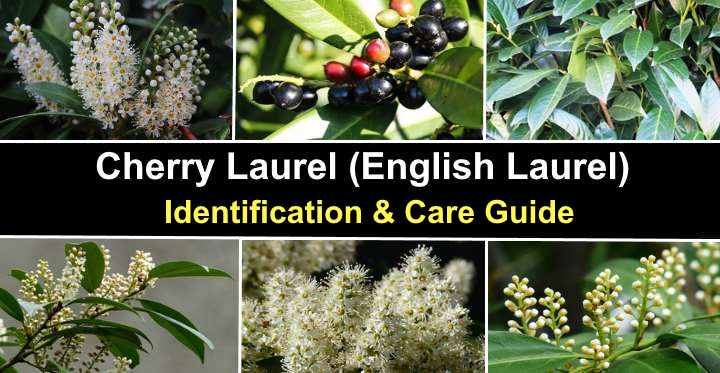
Cherry laurel is an attractive evergreen ornamental shrub. Cherry laurel shrubs create a beautiful flowering hedge or screen due to their glossy green lanceolate leaves, sweet white flowers, and black berries. You can also grow a cherry laurel as a flowering specimen plant or a small tree as a focal point in a garden landscape. A cherry laurel also has characteristics of sweet-smelling flowers and leaves that emit an almond aroma when crushed.
One of the reasons cherry laurel is popular for hedges is its hardiness. The evergreen shrub thrives in full sun to full shade and tolerates some drought. And, as long as it’s planted in well-drained, organically rich soil, it thrives in most soil types. So, with some light annual pruning, you can grow a dense, formal privacy hedge with evergreen foliage in your front or backyard.
This article is a complete guide to identifying the cherry laurel shrub. Along with descriptions and pictures of the plant’s leaves, flowers, and berries, you will find a helpful growing guide.
What is Cherry Laurel (Prunus laurocerasus)
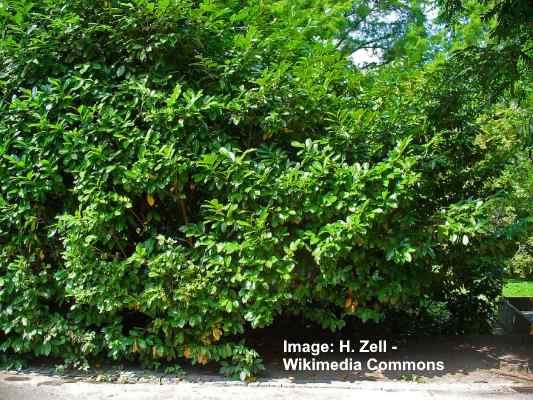
Cherry laurel (Prunus laurocerasus) is an evergreen flowering shrub that is also called English laurel
Cherry laurel is a large evergreen shrub or small tree in the genus Prunus and the family Rosaceae. A cherry laurel shrub can grow between 20 and 30 ft. (6 – 9 m) tall. However, it is easy to maintain a height of 3 – 6 ft. (1 – 2 m) as an evergreen privacy screen.
The name cherry laurel comes from its genus and the shape of the leaves. The shrub is related to cherry trees in the genus Prunus. It has the common name laurel because the leaves look like laurel leaves. However, cherry laurel isn’t related to the laurel tree (Laurus nobilis). And unlike tasty cherry tree fruit, cherry laurel berries are poisonous.
The cherry laurel (Prunus laurocerasus) shouldn’t be confused with the related Prunus caroliniana, also called Carolina cherry laurel. Therefore, the Prunus laurocerasus is often referred to as English Laurel in the United States.
Cherry laurel is a fast-growing ornamental plant that grows around 12” to 24” (30 – 60 cm) per year. This fast growth rate means that you can quickly grow a hedgerow with dense foliage in a few years.
The shrub’s evergreen leaves are also a factor in the plant’s popularity. A cherry laurel hedge keeps its leaves throughout the year. As a result, it provides dense, glossy foliage to enhance privacy in your garden all year long. In spring, when the cherry laurel blooms, clusters of aromatic flowers cover the hedge.
Cherry laurel shrubs are suitable for growing in USDA zones 6 through 8.
Dwarf English Cherry Laurel
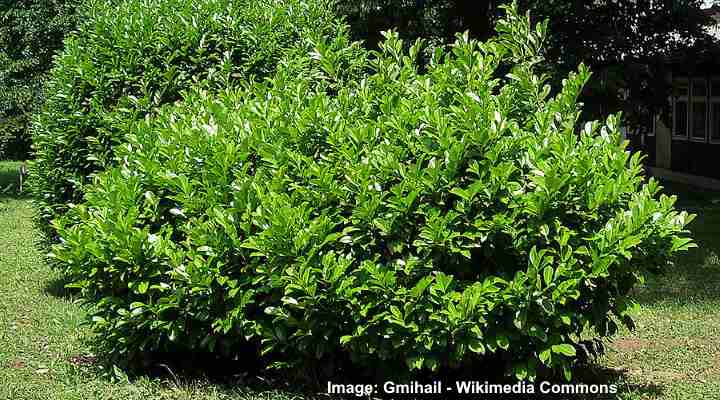
There are several cultivars of dwarf cherry laurel to suit smaller spaces
The dwarf English laurel is a small evergreen shrub that is an ideal hedge plant for a small or compact garden. A dwarf cherry laurel grows between 6 to 8 ft. (1.8 – 2.4 m) tall and up to 6 ft. (1.8 m) wide. The attractive features of the shrub are glossy green leaves, scented spring flowers, and evergreen foliage.
One of the advantages of planting a flowering dwarf cherry laurel is that it grows quickly and is easy to care for. In addition, this hardy drought-tolerant plant grows well in most soils.
The small shrub provides privacy and shade for front and backyards. Additionally, the shrub is easy to maintain as a foundation planting, grow along a fence, or hide unsightly garden structures.
Cherry Laurel Hedge
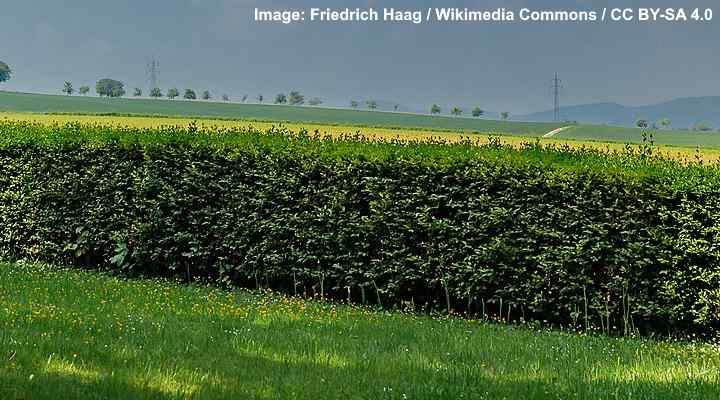
Cherry laurel hedge
A cherry laurel shrub is an excellent choice for a low-maintenance garden hedge, privacy screen, windbreak, or tall border plant. Cherry laurel grows quickly and produces attractive colorful blossoms in the spring and evergreen leaves throughout the year. In addition, the shrub is easy to maintain as a hardy evergreen hedge between 3 and 6.5 ft. (0.9 – 2 m) tall.
The requirements for planting a cherry laurel hedge are minimal. As long as the ground is well-draining and fertile, the evergreen hedge grows in full sun and tolerates heavy shade. It performs best in USDA zones 6 through 8.
Skip laurel (Prunus laurocerasus ‘Schipkaensis’) is a smaller cherry laurel cultivar which is also an excellent choice for hedging.
Cherry Laurel Leaves
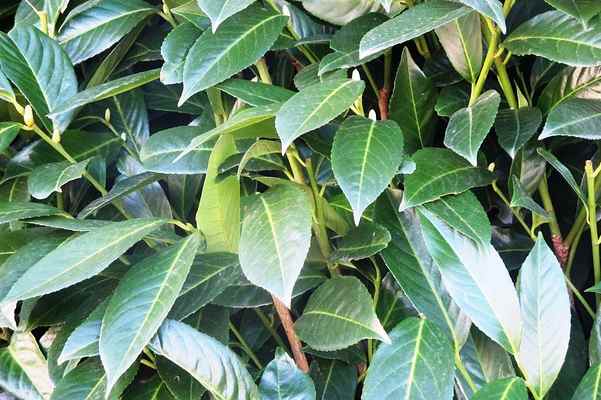
Cherry laurel leaves
The leaves of cherry laurel are identified as dark green, lustrous lance-shaped leaves. The shiny green leaves grow up to 10” (25 cm) long and 5” (12 cm) wide. The laurel leaves have a characteristic smooth shine to them and noticeable greenish-yellow midrib and veins.
Another identifying trait of cherry laurel leaves is their slightly toothed margins.
Although they look similar, you shouldn’t confuse cherry laurel leaves with sweet bay leaves (Laurus nobilis). Leaves from cherry laurel trees emit a sweet, almondy aroma due to cyanide. On the other hand, sweet bay leaves from the bay laurel tree are used in cooking as a spice.
Cherry Laurel Flowers
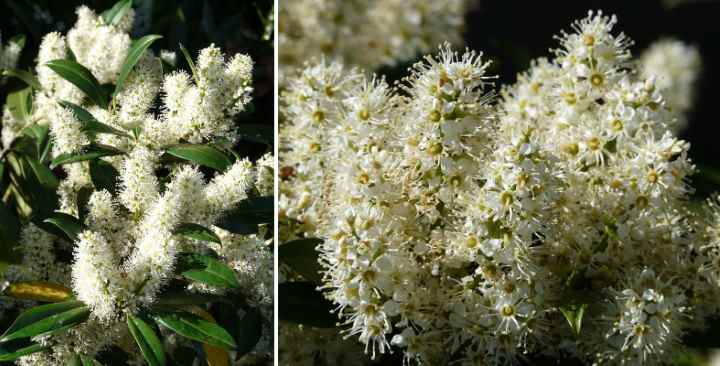
Cherry laurel flowers
Flowers on a cherry laurel shrub are easily identifiable clusters (racemes) of cylindrical white flowers measuring 2.7” to 6” (7 – 15 cm) tall. Each flower has five creamy-white petals and several yellowish-green stamens. Cherry laurel flowers bloom in early spring and persist until April. The flowers give off a sweet plum-like fragrance.
Cherry Laurel Fruit
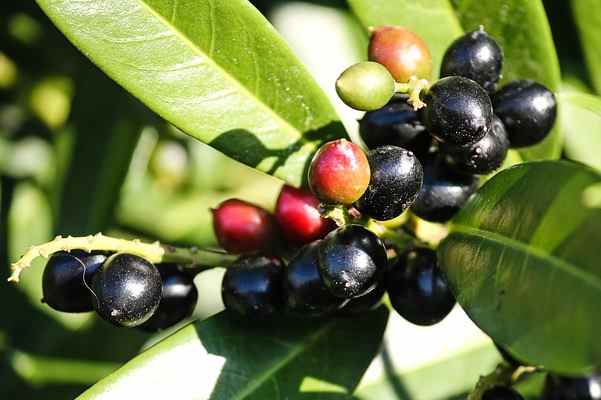
Cherry laurel fruit
Fruit from the cherry laurel bush is clusters of deep red round berries reminiscent of a small cherry. The shiny red berries turn black as they ripen during summer until fall. Like other parts of the plant, the black fruits are poisonous, and you should never eat them. However, the berries will attract birds to your garden.
How to Identify Cherry Laurel
A cherry laurel plant’s primary identification feature is its large, smooth, shiny green leaves. The pointed evergreen leaves create dense foliage. In spring, cherry laurel shrubs bloom with their characteristic pointed cylindrical white flower racemes. After the flowers fade, clusters of dark red and black berries decorate the shrub until fall.
How to Use Cherry Laurel in Your Landscape
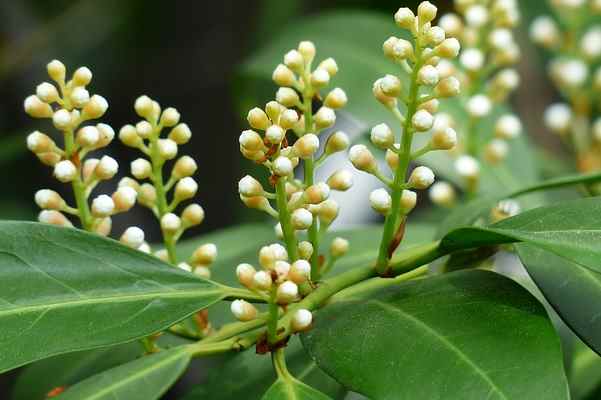
Cherry laurel is a versatile landscaping shrub that can be used for hedging or foundation planting
Cherry laurel shrubs have many versatile uses in a garden landscape. The hardy, fast-growing shrubs grow almost anywhere—shade, full sun, and various soil types. In addition, the hedge plants are ideal for coastal regions as cherry laurel also tolerates salty air.
The most common way to plant cherry laurel shrubs is to create a hedge, privacy screen, or living fence in a row. Plant the cherry laurel shrubs 2.5 to 3 ft. (0.8 – 1 m) apart to grow a cherry laurel hedge. The branches will quickly grow together, creating a dense hedgerow.
Cherry laurel shrubs also make ideal foundation plantings. The hardy plants tolerate regular pruning. You can easily maintain the shrubs at the front of the house, growing below windows.
To reduce work in maintaining evergreen shrubs such as cherry laurel, you can look for compact and dwarf cultivars. Some of these bushes grow to a maximum height of 3 to 6 ft. (1 – 2 m), reducing the need for pruning and shaping.
But suppose you are looking for an attractive evergreen specimen tree for your garden landscape. In that case, you can train cherry laurel to grow as a stunning flowering evergreen tree. All you need to do is remove any suckering stems that appear around the main trunk.
How to Plant Cherry Laurel
Cherry laurels thrive in most garden landscapes with well-draining soil. Plant the nursery shrubs around 3 ft. (1 m) apart to create a flowering evergreen hedge for maximum effect. The branches will soon meet, and you will have an appealing hedge or border growing in your garden.
To grow a cherry laurel, dig a hole that is 1.5 times wider the size of the nursery container and the same depth. Then, use a sharp spade or saw to remove roots circled at the bottom of the pot. Removing these roots ensures you don’t end with girdling roots or a weak plant.
Next, place the root ball in the hole, ensuring the soil line matches the soil level. Next, back-fill the hole with native soil amended with compost. Press the ground down as you fill the hole to remove air pockets. Finally, deeply water the cherry laurel and put a thick layer of mulch around the root area.
Cherry Laurel Care Guide
Cherry laurel is a low-maintenance, easy-to-grow landscaping shrub. Despite this, there are things to know about growing a cherry laurel in your garden to ensure your glossy shrub thrives.
Where to Plant Cherry Laurel in a Garden Landscape
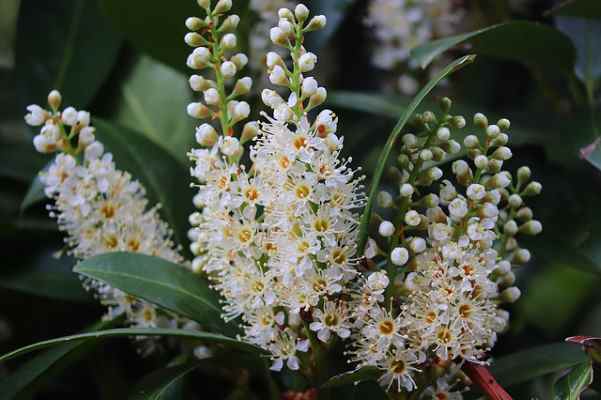
To care properly for your cherry laurel shrub, make sure to plant it in well-drained soil
Grow a cherry laurel shrub in full sun to partial shade. The shrub performs best when it gets at least four to six hours of sunshine daily. However, the hardy plant will also grow well in full shade if you adjust your watering schedule.
A cherry laurel shrub will thrive in most types of soil. However, it is best to ensure that the ground is rich in organic matter.
The critical requirement of growing a cherry laurel is well-drained soil. To tell if the planting site is well-draining, dig a hole 12” (30 cm) deep and wide. Fill the hole with water and allow it to drain. Then, 12 hours later, refill the hole with water. If the water has gone in two to three hours, it is well-draining.
Cherry Laurel Care — Water Requirements
A cherry laurel plant has minimal watering requirements. You just need to water the ground often enough to keep it moist without becoming soggy. However, in temperate climates, regular rainfall is enough to keep the hedge healthy without additional watering. It’s important not to water the soil so much that it becomes waterlogged.
In drier climates, you will need to water a cherry laurel every so often. However, the frequency of watering depends on the weather conditions. As soon as the soil appears dry, give the root area a thorough watering. Then wait until the ground dries before watering again.
Fertilizing Cherry Laurel Hedge
Cherry laurel shrubs have few fertilization needs. However, you can apply a balanced slow-release shrub fertilizer in the fall to boost soil nutrient levels during the dormant period. This type of fertilizer should be applied along the drip line. You could also apply ripe compost or rotted manure to the root area.
Cherry Laurel Pruning Guide
Properly pruning a cherry laurel twice a year is one of the crucial aspects of its care. Hold off pruning until the shrub has finished blooming, and then prune again in the fall.
Therefore, early June is the ideal time to prune a cherry laurel. Cut back some branches to just above the leaf to increase air circulation in the hedge. It is advisable to prune evenly to avoid leaving large gaps in the foliage.
The second time to prune cherry laurel shrubs is at the end of September.
As part of its general maintenance, remove any dead, decaying, or diseased branches. Additionally, suppose you want to grow a cherry laurel tree. In that case, you will need to regularly remove any new stems that emerge around the main trunk.
Cherry Laurel Propagation
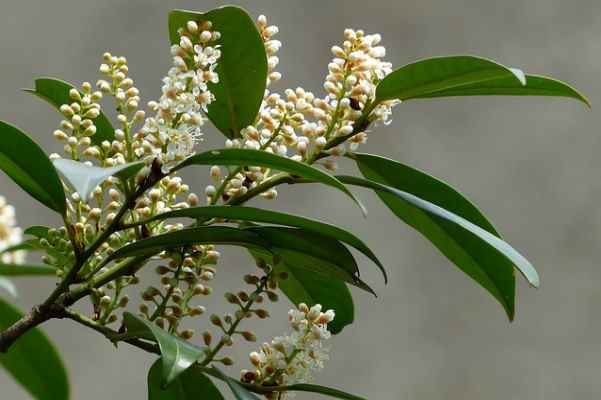
Stem cutting is the best way to propagate cherry laurel
Take stem cuttings in spring from a cherry laurel shrub to grow new plants. Use a sharp, sterilized knife to cut a few healthy stems 6” (15 cm) long to propagate the plant. Remove the lower leaves and strip some bark off the cut end.
Then, dip the end in rooting hormone and plant in a container filled with moist potting soil. Place the container in full sunlight, but keep it sheltered from the wind. Keep the soil moist, but make sure not to overwater it. It will take about one year for cuttings to be strong enough to plant in the garden.
Pests Affecting Cherry Laurel Growth
Healthy cherry laurel shrubs are typically resistant to common garden plant pests. However, pesky insects and bugs like spider mites, thrips, scale insects, beetles, and caterpillars can affect the plant’s growth. Signs of pest infestations on cherry laurel include wilting or yellowing leaves or holes in leaves.
For some insects like thrips, whitefly, and aphids, you can use a strong blast of water from the garden hose to remove the sap-sucking insects.
Hand remove caterpillars from cherry laurel stems and leaves to get rid of the plant-destroying larvae. In addition, you can use sticky horticultural tape to prevent caterpillars from crawling around the shrub’s branches and stems.
Identifying scale insects can be challenging because they look more like bumps on cherry laurel stems. However, scale rarely does enough damage on a Prunus plant to worry about the bugs.
Diseases Affecting Cherry Laurel Growth
Despite being hardy shrubs, cherry laurel plants can be susceptible to fungal and bacterial diseases. Typically, most cherry laurel foliage diseases are due to overwatering or too much humidity. Therefore, the best way to avoid shrub plant diseases is to water your garden plants correctly.
Cherry laurel root rot can cause yellowing leaves, leaf drop, weak stems, and branch die-back. To avoid root rot from killing your evergreen shrub, ensure water drains well from the root area.
Cherry laurel powdery mildew forms when there is poor air circulation in the foliage. This white powdery substance isn’t harmful to the plant. However, the white leaf blotches look unsightly. To avoid powdery mildew, prune the branches to increase airflow through the shrub.
Cherry laurel shot hole is a sign of disease that causes brown patches to develop on leaves. The brown spots become holes, making the leaves look like a shotgun has blasted them. This disease usually occurs in warm, humid conditions during summer. However, cherry laurels typically recover well.
Is Cherry Laurel Toxic?
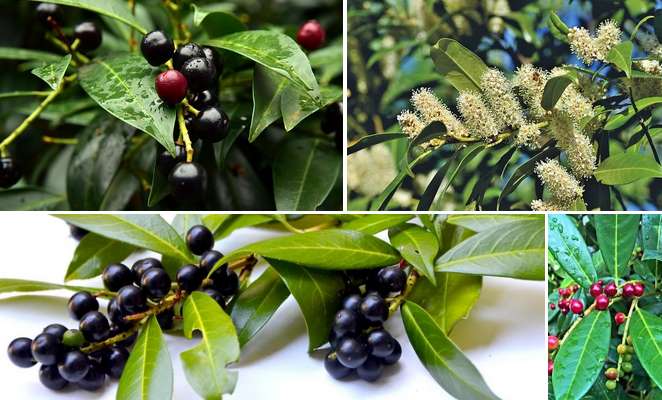
All parts of cherry laurel are toxic
All parts of the cherry laurel plant are toxic. The leaves, seeds, and stems contain poisonous chemicals that can result in shortness of breath, weakness, convulsions, and respiratory failure. Doctors warn that it’s vital to prevent children and pets from accidentally ingesting any part of a cherry laurel shrub.
Cherry Laurel Varieties
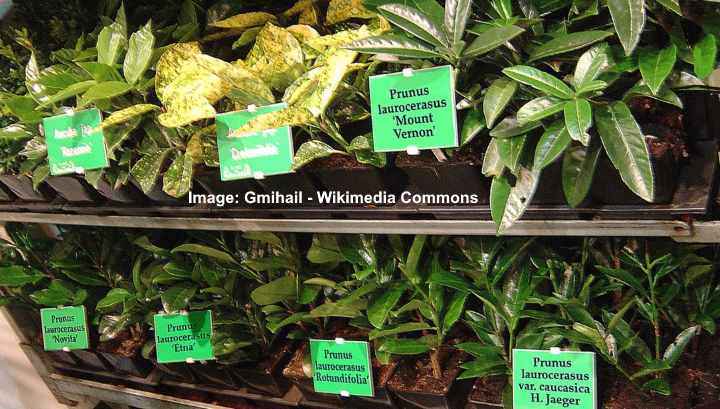
Cherry laurel has various cultivars to suit any garden landscape or size
Here are some varieties of cherry laurel shrubs that are popular for their dwarf habits or variegated leaves:
Prunus laurocerasus ‘Otto Luyken’ – This popular dwarf cherry laurel cultivar is a stunning compact shrub that grows 3 to 4 ft. (1 – 1.2 m) tall and up to 8 ft. (2.4 m) wide. The shrub is prized for its lustrous lance-shaped green leaves.
Prunus laurocerasus ‘Mount Vernon’ – This low-growing cherry laurel variety is ideal for fast-growing ground cover because it only grows 2 ft. (0.6 m) tall but up to 8 ft. (2.4 m) wide. The dense evergreen mound has beautiful pointed, narrow leaves with the characteristic green shine.
Prunus laurocerasus ‘Variegata’ – If you are looking for a cherry laurel with variegated leaves, then the ‘Variegata’ cultivar has shiny green leaves with creamy-white variegation. The slow-growing cherry laurel grows up to 16 ft. (4.9 m) tall.
Prunus laurocerasus ‘Nana’ – This is a slow growing dwarf cherry laurel. The versatile compact shrub can be used as a low informal hedge or accent plant with its dense rounded growth habit. When fully mature, it can reach 6 to 8 ft. (1.8 – 2.4 m) but it can be kept lower as it takes pruning very well.
Related articles:
